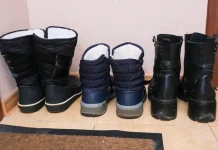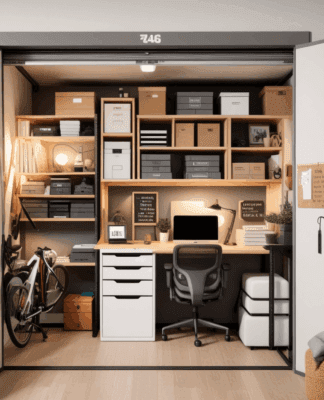Moving during the winter months comes with its own unique set of challenges. From icy walkways to unpredictable weather, it’s important to be prepared and plan ahead to ensure a smooth and safe transition to your new home. Whether braving the snow for a local move or embarking on a cross-country journey, these 14 cold-weather moving tips will help you protect your belongings, stay warm, and make the process as stress-free as possible.
14 Tips for Moving in Winter
Moving in the winter is never fun, but it’s important to make sure it’s safe. Here are some of the best winter moving tips to help you get from point A to point B safely and soundly.
1. Watch the Weather
Winter storms can be unpredictable, so keeping a close eye on the weather is essential. Check for snowstorms, icy conditions, or strong winds in the days leading up to your move. If there’s a severe weather forecast, consider rescheduling your move for another day (if possible). Otherwise, have a backup plan to avoid putting yourself at risk.
2. Be Flexible
Moving in winter often requires more adaptability than a summer move. Roads may close, movers might be delayed, or snowstorms could suddenly appear. Build extra time into your moving schedule to account for potential disruptions, and be ready to adjust plans if conditions become unsafe.
3. Add Extra Padding to Fragile Items
Cold weather can make already fragile items even more sensitive to damage. Add some extra bubble wrap or padding to your boxes to reduce the risk of breaking items like vases or glassware. This might increase the number of boxes you have, but it also helps decrease the risk that your items will break when you move during the winter months. To ensure you have plenty of time to protect everything properly, start early and pay special attention to anything that needs more love.
4. Protect Moving Boxes
One unique challenge of a move in the winter is the potential for cardboard boxes to become wet and soggy. Snow and slush can penetrate boxes and quickly ruin your belongings. Invest in high-quality moving boxes to help keep everything protected during your move, and make sure you lay down plastic tarps inside the moving truck. You may also want to wrap tarps around some stacks of boxes to add an extra layer of protection. Alternatively, you can try to use more plastic boxes or suitcases to protect anything that may become damaged when wet.
5. Protect Electronics from Freezing Temperatures
Some electronics are prone to damage when exposed to sub-zero temperatures. Computers, TVs, and sensitive devices should be protected to reduce the risk of fluctuating temperatures and any associated condensation. You could wrap them in blankets for an added layer of protection or keep them in your car so you can control the temperature of their environment. When you get to your new home, give them time to warm up before plugging them in.
6. Keep Walkways Clear
Snow and ice can make walkways treacherous, especially when carrying heavy furniture or boxes. Before moving day, ensure all sidewalks, driveways, and entryways at your old and new homes are shoveled and salted to prevent slipping. Keep a sturdy snow shovel and a bag of ice melt or sand on hand throughout the day if fresh snow falls or ice becomes slick. Clear paths help protect both movers and your belongings from potential accidents.
7. Protect Your Floors and Carpeting
Winter weather means snow, slush, and mud can easily get tracked into your home, leaving your floors and carpets a mess. Lay down plastic sheets, tarps, or old rugs in high-traffic areas to prevent damage. Consider placing a mat at the entrance for wiping boots, and keep towels nearby to clean up any unexpected messes. If possible, designate one door as the main entry point for movers to minimize the mess.
8. Plan for Utilities
Nothing is worse than arriving at your new home on a freezing day only to discover that the heat hasn’t been turned on yet. Call your utility providers to ensure everything—electricity, water, and especially heat—is up and running before moving day. This ensures your new space is warm and comfortable when you arrive, making the unpacking process more pleasant.
9. Make a Plan for Your Pets
Moving day with a dog or cat can be challenging when the sun is shining, but things can get even more cumbersome in winter. Snow and ice can cause dangerous conditions, and keeping your animals warm is important. During your move, ask friends or family if they can watch your animals until everything has been loaded. This can help give you peace of mind without worrying about your dog dragging slush into your home and soiling carpets or freshly cleaned rooms.
10. Give Yourself Enough Time
One unique challenge of a winter move is the decreased number of daylight hours you have. While the days start getting longer after the winter solstice, you’ll still have significantly less time during the day for winter moves than summer moves. Plan ahead, as the lack of light can make winter challenges even more cumbersome. If you’re doing a DIY move and need to load up a moving truck after the sun has set, be prepared with exterior lights. You may also be able to back your moving truck up to a garage to help ensure that you have enough visibility to take care of things efficiently. If it gets too dark or difficult to navigate, pack things up for the day and start again early. It’s always better to ensure that conditions are safe, especially when moving big or heavy pieces of furniture.
11. Hire Professional Movers
Navigating the winter weather conditions and keeping everyone safe and sound during a move might be a bit much for families with small children and/or pets. If moving during the winter is unavoidable and you’re uncomfortable loading a van in snowy conditions or colder temperatures, hiring a professional is probably best. Just make sure you contact moving companies far enough in advance to ensure someone is available to help!
12. Keep Winter Clothes Accessible
Don’t pack your coats, gloves, scarves, and hats in a box you can’t easily access. Winter gear is essential for staying warm and comfortable on moving days, especially if you spend time outside loading or unloading. Set aside a bag with all the essentials for each family member, and keep it with you in your car or somewhere easy to reach. Layers are your best friend when battling the cold.
13. Don’t Pack Your Winter Supplies
Shovels, ice scrapers, snow blowers, and other winter tools should also remain unpacked and easily accessible. You never know when you’ll need them on moving day—whether to clear snow from your driveway or scrape ice off your windshield. Keeping these supplies handy ensures you’re prepared for any winter surprise that could slow you down. Once the move is complete, these items will also be the first tools you’ll need to settle into your new home.
14. Prepare Your Car for the Big Day
Anyone moving more than an hour or so away should also take the time to get their car ready for moving day. While it might seem unnecessary, cold weather can be hard on your car. When driving long distances, it’s best to ensure everything works as it should. Therefore, we recommend getting your car serviced or tuned up before you hit the road and adding some essentials to create a winter weather emergency kit. This might include extra food and water, snow chains, a spare tire, blankets, and more. Updating your roadside assistance or AAA membership is also a great idea if you’re moving across the country, as these services typically extend coverage to all 50 states and can offer you a big peace of mind while you’re on the road.
An Extra Cold Weather Moving Tip to Help Make the Process Easier
Some moves are easier than others, especially when staying in the neighborhood or state. To help make moving in winter weather a bit easier, you may want to rent a local self-storage unit. Doing so can help you start the process early and reduce the stress of dealing with all your belongings amid a snowstorm. Using short-term self-storage for moving can also give you plenty of time to take care of everything without feeling overwhelmed.
At the Lock Up Self Storage, our climate-controlled self-storage units are perfect for supplementing a move. With flexible leasing options, you can use our self-storage for as long as you need, whether short-term or long-term. Our facilities have top-of-the-line security features like perimeter alarms, gated access codes, and 24/7 CCTV. To learn more about our self-storage units at The Lock Up, give us a call today at 1-866-327-LOCK or stop by one of our locations for a tour of the facility.



















